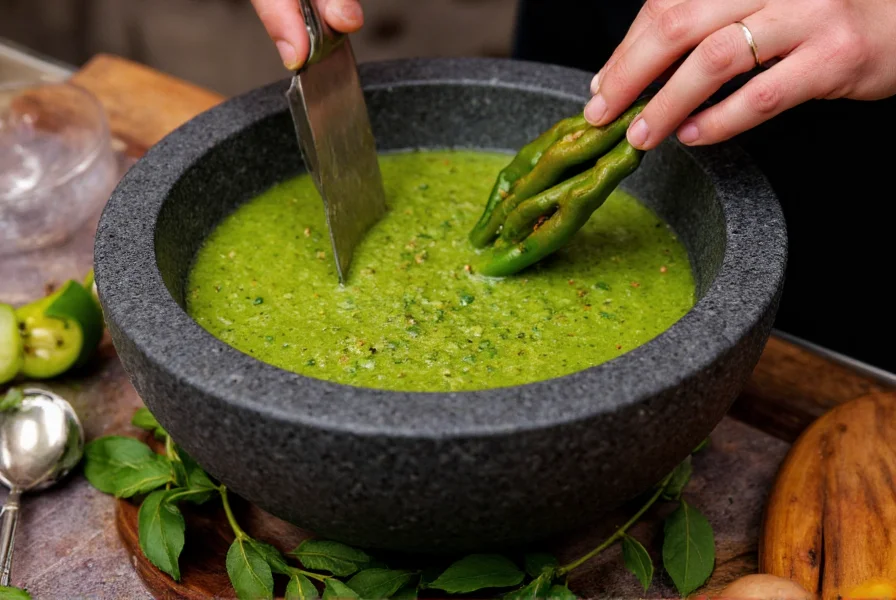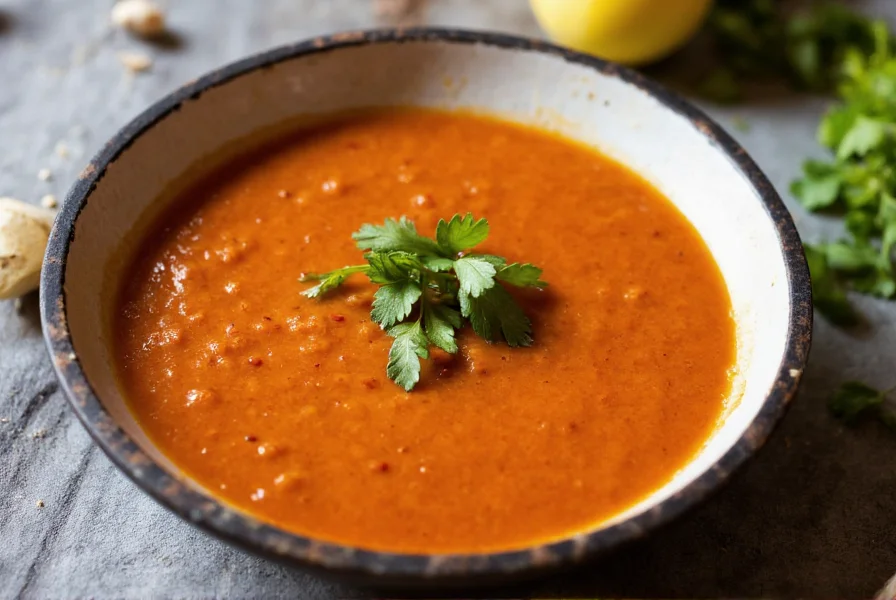Chili verde sauce is a traditional Mexican and Southwestern US green sauce made primarily from tomatillos, green chilies (like serrano or jalapeño peppers), cilantro, onions, and garlic. This tangy, moderately spicy sauce typically ranges from 500-2,500 Scoville heat units depending on the peppers used, and serves as both a cooking base for meats and a finishing sauce for tacos, enchiladas, and other dishes.
Understanding the authentic preparation and applications of chili verde sauce elevates your Mexican cuisine experience beyond typical restaurant versions. This vibrant green sauce forms the backbone of many traditional dishes while offering remarkable versatility in modern cooking.
Origins and Cultural Significance
Chili verde, meaning "green chili" in Spanish, traces its roots to pre-Hispanic Mesoamerican cuisine where indigenous communities first cultivated tomatillos. Unlike red chili sauces that rely on dried peppers, chili verde's distinctive green color comes from fresh, unripe ingredients. The sauce became particularly prominent in Northern Mexico and the Southwestern United States, where it evolved into regional variations while maintaining its essential character.
Traditional Mexican cooks prepare chili verde using a molcajete (volcanic stone mortar) to achieve the ideal texture that balances smoothness with subtle chunkiness. This method releases essential oils from the ingredients while maintaining their fresh character—a technique difficult to replicate with modern blenders.
Essential Ingredients for Authentic Flavor
The magic of a perfect authentic chili verde sauce recipe lies in ingredient quality and proper preparation:
- Tomatillos (1-1.5 lbs): These husked green fruits provide the tart foundation. Look for firm, bright green specimens that fill their husks completely.
- Green chilies (4-8 serranos or 2-4 jalapeños): Serranos deliver traditional heat while jalapeños offer milder flavor. Always remove seeds and membranes to control spiciness.
- White onion (1 medium): Raw onion would overpower, so roasting or boiling mellows its sharpness.
- Cilantro (1 cup packed): Adds the characteristic herbal note essential to traditional Mexican chili verde ingredients.
- Garlic (3-4 cloves): Roasted for sweetness rather than raw pungency.
- Chicken or vegetable broth (1 cup): Adjusts consistency without diluting flavor.
- Seasoning: Salt to taste, plus optional cumin (1/4 tsp) for depth.
| Ingredient | Traditional Preparation | Flavor Contribution |
|---|---|---|
| Tomatillos | Boiled or roasted until softened | Tart, citrus-like base with vegetal notes |
| Green chilies | Roasted over open flame or boiled | Grassy heat with varying intensity |
| Cilantro | Added fresh after cooking | Bright, herbal freshness |
| Onion & garlic | Roasted or boiled with tomatillos | Savory depth without sharpness |
Step-by-Step Preparation Guide
Creating the ideal homemade chili verde sauce requires attention to cooking technique:
- Prepare ingredients: Remove husks from tomatillos and rinse off sticky residue. Stem chilies and remove seeds/membranes for milder sauce.
- Cook base ingredients: Place tomatillos, chilies, onion quarters, and garlic cloves in a saucepan with enough water to cover. Boil for 10-12 minutes until tomatillos change from bright to olive green and soften.
- Blend carefully: Drain ingredients, reserving 1/2 cup cooking liquid. Transfer to blender with cilantro and salt. Blend in short pulses to maintain some texture—over-blending creates foam and diminishes flavor.
- Adjust consistency: Add reserved cooking liquid gradually until reaching desired thickness. For chili verde sauce for chicken, slightly thinner consistency helps the sauce penetrate meat during cooking.
- Final seasoning: Simmer sauce for 5-7 minutes to meld flavors, then adjust salt. Authentic versions rarely include thickening agents—rely on natural pectin from properly cooked tomatillos.

Chili Verde vs. Green Enchilada Sauce
Many confuse these two sauces, but key differences exist:
- Chili verde uses fresh tomatillos as the primary ingredient, creating a brighter, tangier profile with visible green color from unripe produce.
- Green enchilada sauce typically combines roasted green chilies with a roux or cornstarch base, resulting in a smoother, thicker sauce with less pronounced tartness.
When seeking the best green chili sauce for chicken, chili verde's acidity helps tenderize meat while its herbal notes complement poultry beautifully—particularly in slow-cooked dishes like chicken verde.
Perfect Pairings and Culinary Applications
While excellent as a dipping sauce, chili verde truly shines when incorporated into dishes:
- Protein preparations: Marinate chicken thighs or pork shoulder before slow cooking for authentic chili verde stew
- Enchiladas: Use as both cooking liquid and finishing sauce for vibrant green enchiladas
- Breakfast applications: Drizzle over huevos rancheros or scrambled eggs
- Soup base: Create pozole verde by adding hominy to simmering sauce
- Modern fusion: Blend with Greek yogurt for a spicy dip or mix with mayonnaise for sandwiches
Storage and Preservation Techniques
Proper handling maintains flavor and safety of your chili verde sauce storage:
- Refrigeration: Store in airtight container for up to 1 week—the acidity helps preservation
- Freezing: Portion into ice cube trays, then transfer frozen cubes to freezer bags for up to 6 months
- Canning: Requires proper pH testing and pressure canning due to low-acid ingredients
- Reheating: Gently warm without boiling to preserve fresh flavor profile
Notice flavor degradation when sauce separates or develops off-odors. Freshly made sauce should have vibrant green color that darkens slightly when cooked but shouldn't turn brown.
Common Preparation Mistakes to Avoid
Even experienced cooks make these errors when attempting how to make homemade chili verde:
- Using underripe tomatillos: They should fill their husks completely and feel firm
- Over-blending: Creates foam and diminishes fresh flavor through oxidation
- Adding lime juice: Authentic versions rely on tomatillo tartness rather than citrus
- Using dried peppers: True chili verde requires fresh green chilies, not dried alternatives
- Insufficient cooking: Raw tomatillo flavor remains harsh until properly softened
For consistent results, always taste your sauce before final seasoning. The balance of tart tomatillo, herbal cilantro, and moderate heat defines authentic chili verde—adjust ingredients proportionally rather than adding extraneous elements.
Frequently Asked Questions
What's the difference between chili verde and salsa verde?
While both use tomatillos, chili verde is cooked and typically smoother with a more integrated flavor profile, while salsa verde remains raw or minimally cooked with more distinct ingredient textures. Chili verde generally has a deeper, more complex flavor from the cooking process and is used as both cooking sauce and condiment, whereas salsa verde functions primarily as a fresh condiment.
Can I make chili verde sauce without tomatillos?
Traditional chili verde requires tomatillos for its distinctive tart flavor. While some modern variations substitute green tomatoes, the result lacks the characteristic citrus notes of authentic tomatillos. For true traditional Mexican chili verde ingredients, tomatillos are essential—they're available year-round in most grocery stores and frozen when fresh ones aren't in season.
How can I reduce the heat level in chili verde sauce?
To create a milder chili verde sauce for chicken or family-friendly version, remove all seeds and white membranes from the chilies before cooking. Using poblano peppers instead of serranos significantly reduces heat while maintaining flavor. You can also add 1-2 tablespoons of honey or roasted sweet corn to balance spiciness without compromising authenticity.
Why did my chili verde sauce turn brown?
Browning occurs when the sauce is overcooked or exposed to air too long. Tomatillos contain enzymes that cause oxidation when blended excessively. To prevent this, blend just until combined, avoid boiling the finished sauce, and store with plastic wrap pressed directly against the surface to minimize air exposure. Freshly made sauce should maintain vibrant green color for several days when properly stored.
Can I use canned tomatillos for chili verde sauce?
While fresh tomatillos are preferred for the brightest flavor, high-quality canned tomatillos make an acceptable substitute when fresh ones aren't available. Drain and rinse them thoroughly to remove preservative flavors, then reduce added liquid in the recipe. The texture may be slightly softer, but the sauce will still deliver authentic what is chili verde sauce made of character when properly seasoned.











 浙公网安备
33010002000092号
浙公网安备
33010002000092号 浙B2-20120091-4
浙B2-20120091-4